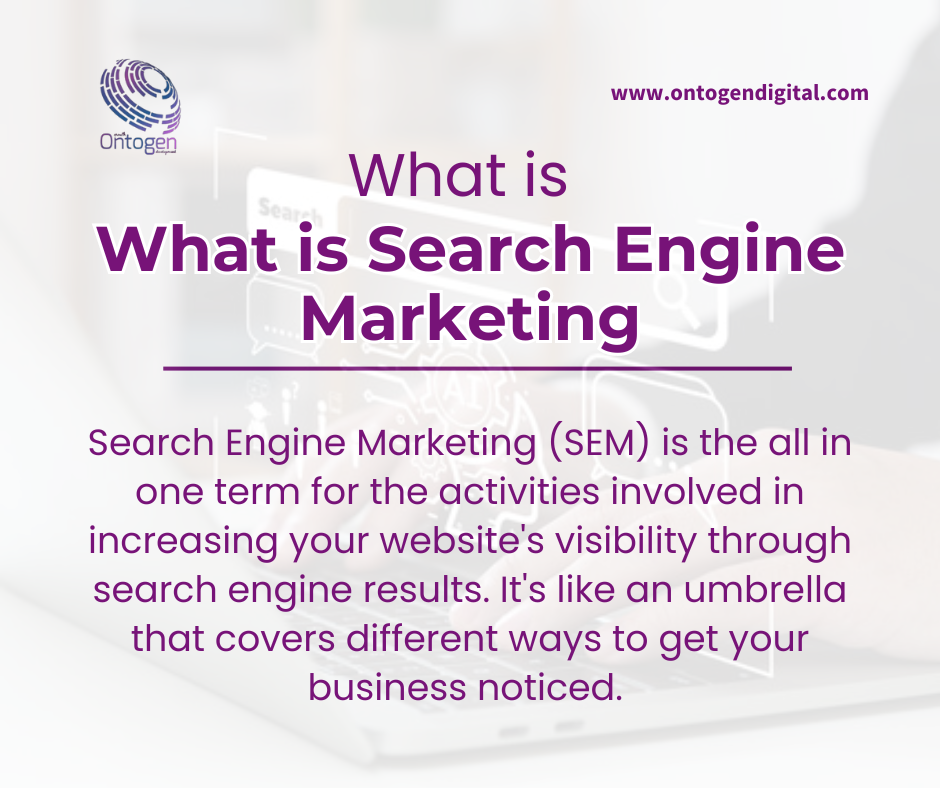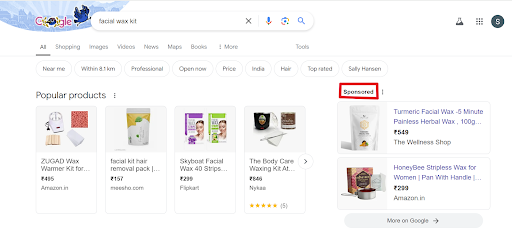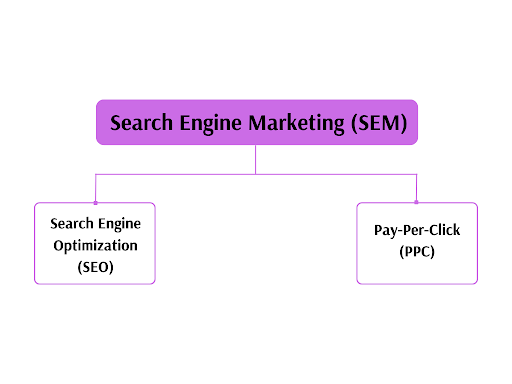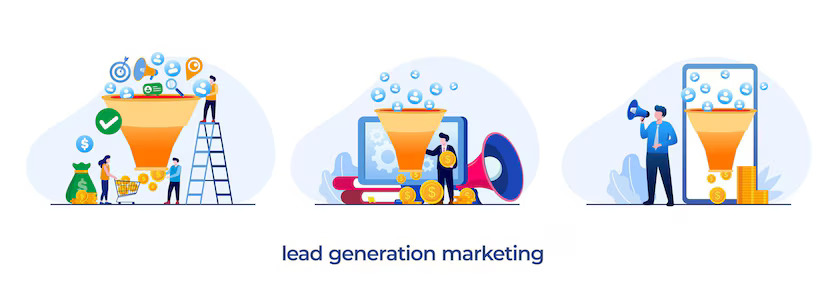18 July 2024 |
By - Sudha Mariappan

Using SEO and SEM can greatly improve your website quality, attract traffic, generate more leads, increase revenue, and grow your business. It all comes down to one thing, improving your website's quality and visibility.
Most search engine results are organic results. But when your business isn’t getting the reach you need through organic results, you need to rely on Search Engine Marketing.
As more than 70 percent of shoppers are mobile users globally, you have a greater chance to optimize your website to be more mobile friendly, and invest in SEM in a crowded online marketplace to secure your profit.
Each marketing tool serves its own purpose. One powerful tool that can help you achieve this is Search Engine Marketing (SEM). But what exactly is SEM, and how does it differ from SEO?
Search Engine Marketing:
Search Engine Marketing (SEM) is the all in one term for the activities involved in increasing your website's visibility through search engine results. It's like an umbrella that covers different ways to get your business noticed.
So how does it work?
It works through paid advertising. You pay to have your website be on top of the results. To achieve that, you literally buy an ad space. What happens as a result of this is that you literally get charged every time that someone clicks on your ad. This is also called Pay-Per-Click, or PPC advertising.
The next one is Organic search.
This is when your site naturally appears in the search results because it is relevant to what the user is typing in. An organic ranking can only ever be achieved through optimizing your website.
For example, one of our blogs written about Meta AI, has been ranked first through organic search.
In simple words, SEM is about ensuring you show up first in the search results, whether or not you paid for that to happen.
A simple way to know whether a business is using SEM for their marketing is when there is “sponsored” word above the Ad displayed on the search engine page.
For example, if we type “facial wax kit” on the search engine bar of google, it shows organic as well as “sponsored” brands, which are paid ads meant to be displayed in the front.

SEM vs SEO: Understanding the Difference
While SEM is a broad term, SEO and PPC are its two major constituents. Let's break down the difference between the two:

PPC also known as pay per click is a type of advertising where you pay every time someone clicks on your ad. This can bring instant business, but it will get pretty expensive if not done right. Which is better?
Well, that depends on what you are trying to do with your business goals, budget, and timeline. Many businesses need both SEO and PPC running for the best results.
SEO is like building a strong base for any online presence. It's long term and much effort has to be put into building it, though the effects could be very long-lasting. However, PPC is more or less of an instant boost to make one instantly noticeable.
Read Also: 7 Landing page optimization secrets for sales success.
The Two Main Types of SEM:
Pay-Per-Click (PPC) Advertising:
Pay Per Click advertising is an advertising tool used to drive traffic to websites. Advertisers have to pay for an ad to pay the publisher, typically a search engine or a website owner. When the ad is clicked, the advertiser gets to pay an amount.
Having PPC is helpful as you don’t need to wait for visitors to click on your ad. It might be a shortcut but it does get you to the front of the line.
Here’s how Pay Per Click works:
- Step 1: Your business advertiser creates an ad, which includes a text ad, a banner, or even a video.
- Step 2: Your Ad is displayed when users search for related keywords or visit a relevant website, your ad pops up.
- Step 3: When a user clicks on the ad, you have to pay for the click they made while opening your Ad.
- Step 4: Your user is directed to your website to your landing page that continues the user’s journey with an offer or content.
PPC advertising target with precision. As stated in one of our blogs, PPC allows you to target your ads by using certain keywords such as Demographics, location, time and even device that is used.
It’s cost effective. Unlike traditional advertising campaigns where you have to buy ad space and wait for engagement, you can only pay for when a user shows interest in your ad.
No amount of your business will be spent randomly, instead this marketing campaign makes sure that the ads are reaching out to the intended audience.
We have discussed Search Engine Optimization on many blogs, however, this is an important tool which is used under Search Engine Marketing to optimize your website. To make your brand visible, search engines recommend SEO practices that enhance the user experience and page ranking.
This is done by using relevant keywords in titles, meta descriptions, and headlines.
If you want to show up on the first page of Search Engine Results Page (SERP), feature descriptive URLs with relevant keywords.
So how does SEO Work?
SEO is a process which has three stages. The primary stage is divided into two stages, on page and off page seo. Once we are done with the on page optimization we work on technical SEO.
While there are paid SEOs to work on, on-page and off-page SEOs are basically free to use. SEOs are mainly used to build your brand visibility by organic methods.
However, in paid SEO, the bidding is done on the highest ranking keyword possible, which the business can use to make their product or service rank to the top.
Get your free checklist on basics of off-page SEO.
Off-page and On-page SEO differ in significant ways. Off-page SEO is used when your website needs backlinks, brand mentions, and social signals.
Adding this information will show that a website is equally valuable and trustworthy. Search engines will know that your content is not just relevant, but authoritative and credible.
On-page SEO on the other hand, is the face of your website. It includes the content, URLs, and good visuals. On-page SEO is as crucial as off-page SEO.
Get your free checklist on basics of on-page SEO.
Benefits of SEM to Businesses:
You can use on-page and off-page SEO for organic reach. But when some search queries become too competitive, you have no choice but to use Search Engine Marketing. If effectively used, SEM can literally be a game-changing initiative for a business.
Here are some benefits of SEM:
Increased Visibility:
Increasing visibility is a must if you want to boost your sales. With SEM, your customers can easily see your product displayed at the very top of the search engine, and gain more engagement.
People's searches of the products and services your business deals in are likely to showcase your advertisement or website right on the spot. That basically means that more people are aware of your business, even if they have no clue about you.
Targeted Reach:
There are so many reasons why SEM works great, which includes the fact that SEM reaches the right people. You could configure your ad setting to reach the person you want to show it to.
For example, in the case of kids' clothing sales, parents of young children are the target. This ensures that your marketing efforts are focused on people who are most likely to be interested in your products or services.
Measurable Results:
The good thing about SEM over the traditional forms of advertising is that it gives you definite and measurable results. You can see how many people clicked on your ad to visit your website and proceed to buy from you.
Such information is very useful to know what is effective and actually works in your favor. It is something similar to having a real-time dashboard, which will show you the performance of your business.
You can measure your results by Key Performance Indicators, which are discussed below.
Read Also: The future of marketing is here: 5 ways to use data analytics to improve your marketing campaigns.
Getting Started with SEM:
1. Setting Clear Goals:

But before you begin, you have to specify what you want out of an SEM campaign. Do you wish to maximize sales, generate leads, or create awareness regarding your brand?
If the targets are clear, concentration will follow, and thus comes a measurement of success. Setting destinations in mind with clarity is like charting a course for your journey; otherwise, you might get lost.
2.Keyword Selection:
Keywords are the words to be used by people in searching for these kinds of products or services. What would really support your SEM campaign to be successful is choosing the right keywords. Profitable keywords with high search volume and low difficulty are best.
For example, if you sell handmade jewelry, relevant keywords could be "handmade jewelry," "silver jewelry," or even "beaded necklaces." Utilize useful tools like Google Keyword Planner to find keywords that are most popular and relevant to your business.
Your ad copy is the text people see after clicking your ad. The ad copy needs to be riveting, informative, really persuasive, and will force people to really click on your website.
Outline the principal benefits of your product or service, and remember to have strong calls to action in the likes of "Shop Now" or "Learn More."
This means that the space at your disposal is quite limited, every word should count.
Measuring SEM Success:
Keep track of your performance and analyze it to bring out the best in your SEM campaigns.
Key Performance Indicators:
KPIs are metrics allowing a degree of measurement regarding the success of your SEM campaigns.
Some important KPIs include:
- Clickthrough rate (CTR): The percentage that clicks on your ad after having viewed it.
- Conversion rate: A percentage of persons who have undergone a desired action.
- Cost per Click (CPC): What you pay for each click on your ad.
- Return on Investment (ROI): The profit made for every rupee spent on advertising.
Analyzing Your Results:
Keep looking at your SEM data from time to time to understand the trends and areas of improvement. Identify those keywords doing well and those that are not. Try different ad copies and landing pages to see what works best.
Optimizing Your Campaigns:
SEM is a continuous process. You will then be able to modify and optimize your campaigns for better performance based on your analysis. This could include pausing underperforming keywords, creating new ad groups, or testing ad copy or landing pages.
Search Engine Marketing has its own separate economy base. It has an importance a lot of people didn’t grasp about. It has existed as long as the internet, and changed significantly throughout the years.
Connect with us at info@ontogendigital.com if you need any Digital Marketing services. Through SEM, SEO, PPC marketing, we can build your engagement to high traffic. Also, if you found this blog useful, subscribe to us for more such blogs.
KEY TAKEAWAYS:
- SEM uses paid advertising so that it helps improve your website quality, attract traffic, generate more leads, increase revenue, and grow your business.
- It involves both paid search in PPC campaigns and organic search optimization.
- PPC ads are paid by clicks and will get you more visibility and engagement right away.
- SEO brings long-term exposure by optimizing the websites for organic search rankings.
- SEM will help your business through its measurable results, targeted reach, and huge boosts in sales and brand awareness.